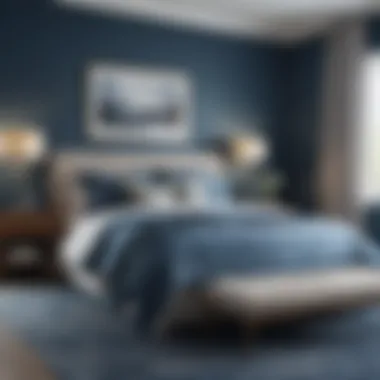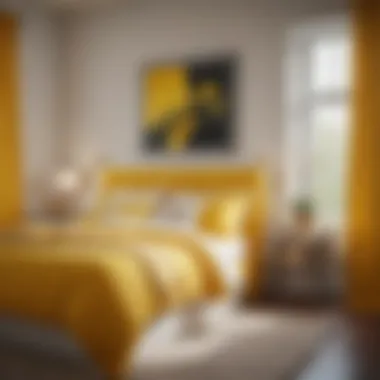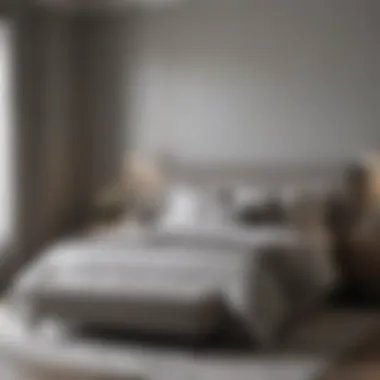Top Ten Bedroom Colors for Inspired Spaces


Intro
Choosing the right color for a bedroom is not just about aesthetics; it deeply influences mood and functionality. For many homeowners, this decision shapes their environment, offering a personal sanctuary. Understanding the implications of color can inform choices that reflect individual styles and needs. This article explores ten outstanding bedroom colors, emphasizing both their psychological impacts and their visual appeal.
By delving into the trending palettes and exploring established notions, one can refine their bedroom space into a retreat that nurtures both comfort and inspiration.
Design Inspiration
Current Interior Design Trends
The realm of interior design is ever-evolving. In recent years, there has been a discernible shift towards more introspective and restorative hues. Colors such as soft greens, muted blues, and warm earth tones have garnered attention for their calming effects.
Homeowners are increasingly opting for colors that not only beautify but also promote well-being. Minimalist designs with organic accents play well with these colors, enhancing overall harmony in the room. As a result, contemporary design emphasizes balance, sustainability, and emotional resonance.
Color Palettes and Their Effects
Selecting a color palette requires an awareness of emotional responses and environmental impact. Here are some popular choices and their associated effects:
- Soft Blue: Known for its calming nature, soft blue can help reduce stress and promote tranquility.
- Warm Beige: This color offers a sense of warmth and welcome, making spaces feel cozy and inviting.
- Earthy Greens: Greens evoke the serenity of nature, fostering relaxation and rejuvenation.
- Deep Violet: Though bold, deep violet can create a luxurious atmosphere, evoking a sense of creativity and inspiration.
Selecting complementary colors for accents—like throw pillows or artwork—can enhance the overall impact. The right mix not only elevates style but also reinforces the desired mood of the space.
"Color is the keyboard; the eyes are the harmonies; the soul is the piano with many strings."
- Wassily Kandinsky
In this dynamic landscape of color choices, understanding each hue's potential is crucial for anyone looking to improve their bedroom experience. Equipping oneself with this knowledge lays the groundwork for smart, informed decisions.
Prolusion to Bedroom Color Psychology
Color holds significant influence over human emotions and behaviors. In the domain of interior design, understanding this principle is crucial. This section will explore how color shapes the ambiance of a bedroom and impacts the overall user experience. Bedrooms are personal spaces where individuals seek comfort and relaxation. The colors chosen for these spaces not only reflect personal taste but also affect mood, making it vital to thoughtfully consider each color's psychological implications.
Understanding Color Psychology
Color psychology studies how colors affect human perception and behavior. Each hue carries its own emotional weight. For example, blue is often associated with calmness and serenity, while red can evoke passion or intensity.
Research suggests that color exposure affects mood and can enhance or diminish feelings of stress and relaxation. Selecting the right color for a bedroom is, therefore, an exercise in psychological understanding. Homeowners can utilize this knowledge to create environments conducive to rest and rejuvenation. This understanding of color psychology helps guide selections that align with desired feelings in a personal space.
Importance of Color in Bedroom Design
Color selection in bedroom design is more than an aesthetic choice; it serves as a foundation for the room's atmosphere. The color palette influences not just the visual appeal but also impacts the emotional and psychological responses of the inhabitants.
Key aspects of color importance include:
- Mood Enhancement: Specific colors can elevate mood and encourage relaxation. A soft palette may cultivate peacefulness, while darker shades can provide a sense of coziness.
- Personalization: Bedrooms serve as reflections of individual style. This personalization can enhance emotional well-being, making the space more welcoming and secure.
- Design Cohesion: Color is a unifying element. Selecting colors that harmonize with furnishings and décor creates a coherent design.
"The colors in a bedroom should harmonize with the individual's lifestyle and emotional needs."
In summary, these factors underscore the critical role color plays in bedroom design. Thoughtful consideration will yield spaces that are visually appealing, effectively functional, and emotionally supportive.
The Criteria for Selecting Bedroom Colors
Selecting the right color for a bedroom is a critical choice that affects both aesthetic appeal and emotional well-being. The criteria for this selection involve practical, psychological, and stylistic considerations, all of which play vital roles in creating a harmonious environment. Choosing a bedroom color goes beyond mere preference; it impacts mood, energy, and functionality. Distinct color palettes can inspire restful sleep or stimulate creativity. This section explores the core criteria that should guide homeowners when deciding on bedroom colors.
Mood and Atmosphere Considerations


When picking a color, it is essential to think about the mood one wants to cultivate in the bedroom. Colors elicit emotional responses, significantly influencing how we feel in a space. For instance, soft hues like blues and greens often promote relaxation, encouraging a tranquil atmosphere. Dark tones can evoke a feeling of coziness but may also compact the space visually. Here are some key factors to consider:
- Personal Preference: What colors resonate most with you? Select shades that align with your emotional state.
- Desired Ambiance: Are you aiming for a calm retreat or a more energizing space to inspire creativity?
- Psychological Effects: Research indicates that warmer colors can stimulate feelings of happiness and comfort, while cooler tones may calm the mind and body.
By identifying what kind of mood you want to achieve, you set a clear direction for selecting the right colors.
Compatibility with écor Styles
Each decor style embodies its unique characteristics, and bedroom colors should complement those aspects. For example, a minimalist approach often pairs well with neutral and soft colors that accentuate simplicity. On the other hand, a bohemian style thrives on rich, vibrant hues that create a sense of vitality. Here are a few considerations:
- Design Coordination: Ensure the color complements existing elements like furniture, textiles, and artwork.
- Holistic Approach: Think about how the color will integrate with the overall design theme.
- Flexibility for Changes: While selecting a color, consider future decor changes. Choosing versatile shades can minimize the need for frequent repainting.
Selecting a color that harmonizes with your decor not only enhances the visual appeal but also solidifies a cohesive design narrative.
Light and Space Dynamics
The interplay of light and color is crucial in any room, especially in a bedroom. Natural light brings out the richness of paint shades, while artificial light can alter how colors are perceived at night. Also, a room's size significantly influences color choices; lighter colors can make a small space feel larger, while darker hues can add warmth and intimacy. Important factors include:
- Type of Light: Evaluate whether your room receives ample sunlight or relies on artificial lighting. Natural light often brightens colors, whereas artificial lighting might dull them.
- Room Dimensions: Consider how the size of your room can change the perception of colors. Light shades work well for smaller rooms, making them feel airy, while darker shades suit larger spaces for a more cozy vibe.
- Seasonal Variations: Colors may appear different depending on the season. It can be wise to pause and observe how the colors respond to changing light conditions during different times of the day.
Understanding these dynamics will enable homeowners to select colors that are not only visually appealing but also functional, adapting well to various lighting and spatial contexts.
Analyzing the Top Ten Bedroom Colors
Understanding the top bedroom colors is essential because colors play a key role in setting the mood, enhancing aesthetics, and ensuring harmony with various interior design elements. This article delves into ten carefully selected shades designed to inspire and nourish personal spaces, focusing on their psychological effects, aesthetic qualities, and adaptability to different decors. Choosing the right colors not only enhances visual appeal but also contributes to emotional well-being and functionality within the bedroom.
Serene Blue
Shades and Tones
Serene blue encompasses a variety of shades, from soft pastels to deep navy. This range offers a peaceful backdrop that can make a bedroom feel more tranquil. The lighter shades tend to be airy and refreshing, making them a popular choice for creating calm environments. The unique characteristic of serene blue is its ability to evoke feelings of calmness and security, which is particularly beneficial for bedrooms, a space meant for relaxation. However, darker tones could risk making a room feel smaller if used excessively without proper lighting.
Effects on Sleep Quality
Studies suggest that serene blue shades can enhance sleep quality. The calming effect of blue reduces heart rates and induces relaxation. This color works to create a peaceful environment, making it easier to unwind after a long day. The benefit of using blue in a bedroom lies in its subtle hue sensitivity to changing light conditions, which contributes positively to the sleep quality of its occupants. Nevertheless, it’s crucial to balance blue with warm accents to avoid a potentially cold atmosphere.
Calming Green
Natural Vibe
Calming green reflects elements of nature, creating a relaxed atmosphere in the bedroom. This color promotes a sense of balance and tranquility, making it a popular choice among homeowners. The unique aspect of calming green is its versatility, adapting beautifully to various themes, from contemporary to rustic. Its advantage lies in its soothing qualities, but too much green can overshadow other design elements, leading to a monochromatic scheme that lacks dynamics.
Harmony with Nature Themes
Green’s connection to nature fosters a peaceful ambiance, perfect for a restful retreat. This focus on organic elements enhances the harmony of the bedroom with outdoor surroundings. The notable characteristic of green is its ability to promote regeneration and freshness. While beneficial, ensuring a diverse palette within green shades is essential to maintain visual interest and prevent the space from feeling overly secluded.
Neutral Gray
Versatility Across Designs
Neutral gray offers exceptional adaptability, serving as a backdrop for a range of design styles. This color works seamlessly with both bold and muted designs, allowing for a diverse array of aesthetics. The unique feature of gray lies in its ability to balance bolder colors and patterns, creating a sophisticated appearance. Despite its many advantages, a potential downside of gray is that it may appear too flat if not accented properly.
Creating Depth and Dimension
Utilizing neutral gray can add layers of depth and dimension to a bedroom. This effect can be achieved through careful layering of textures and the use of varied shades. The key characteristic of gray is its malleability; it can be cool or warm depending on accompanying colors. One disadvantage is that too much gray can lead to a dull atmosphere, necessitating the introduction of accents or textures to invigorate the space.


Warm Beige
Comfort and Coziness
Warm beige is synonymous with comfort and warmth, making it an ideal choice for bedrooms. This color envelops the space, creating a cozy feeling essential for relaxation. Its key characteristic is its neutral undertones that can warm up a room with minimal effort. The unique aspect of warm beige is that it ties well with many other colors, but excessive use can sometimes make the space feel one-dimensional.
Enhancing Natural Light
Warm beige has an innate ability to reflect natural light, enhancing brightness within the room. This color creates an inviting atmosphere while ensuring the room feels larger. The benefit here is that it works well in spaces with varying degrees of light exposure. However, if the room lacks good lighting, beige shades can appear bland or dull, demanding careful consideration in their application.
Elegant White
Timeless Choice
Elegant white stands as a timeless option for bedroom design, offering a fresh, clean slate for creativity. Its fundamental advantage is its ability to make spaces appear larger and more inviting. The unique trait of white is its versatility, allowing it to mix seamlessly with any decor style. However, an all-white scheme can sometimes lack warmth or personality, necessitating the integration of textured elements or colors to avoid feeling sterile.
Emphasizing Space and Cleanliness
Using white in bedroom design emphasizes a sense of openness and cleanliness, which contributes to a calm atmosphere. The key aspect is that it projects clarity and order, ideal for relaxation. One downside is that white surfaces can be prone to showing dirt and wear, requiring additional maintenance. Nevertheless, pairing white with colorful elements can enhance the overall aesthetic while retaining its clean appearance.
Rich Charcoal
Modern Appeal
Rich charcoal is increasingly popular in modern bedroom design. This color adds sophistication and depth, presenting a striking contrast to lighter tones. Its notable characteristic is the elegant touch it gives to any décor while providing an edgy appeal. However, heavy use of charcoal can darken a small space, making careful application necessary to maintain a balanced feel.
Contrast with Bright Accents
When paired with bright accents, rich charcoal creates visually appealing contrasts that enhance the room's aesthetics. This interplay between dark and bright elements adds dynamism to the bedroom. The distinctive angle of this color scheme is its capability to elevate other colors. Yet, if overdone, the bright accents can clash with the weight of the charcoal, resulting in a disjointed look.
Soft Lavender
Calming Influences
Soft lavender offers a gentle aura, promoting relaxation within the bedroom. Its soft tone contributes to a calm environment, perfect for unwinding. The unique feature of this shade is its ability to stimulate creativity while also fostering a soothing atmosphere. However, not enough lavender in a room can result in it being overpowered by stronger hues, which could diminish its calming effects.
Balance with Natural Elements
Soft lavender works harmoniously with natural elements, enhancing the organic feel of the room. This color can be beautifully incorporated with wooden features, floral patterns, and greenery. The strong point is that it invites a sense of tranquility, infused with nature’s charm. However, excessive use of lavender can lead to a space feeling overly feminine, necessitating a blend with more neutral palettes for balance.
Vibrant Navy
Creating a Bold Statement
Vibrant navy provides an opportunity to create a strong focal point in a bedroom. Its deep hue delivers drama and sophistication, appealing to those looking for impactful design. The unique aspect of navy is its timelessness, which seamlessly blends classic and modern styles. Yet, if not carefully balanced with lighter tones, navy can overwhelm a space, making it crucial to use it strategically.
Pairing with Metallic Accents
Navy complements metallic accents effectively, adding a luxurious feel to the bedroom. The interplay between the deep blue and shiny elements creates an exquisite visual identity. The standout quality of this pairing is that it enhances the overall richness of the decor. Conversely, too many metallic accents can distract from the navy’s boldness, necessitating moderation and careful arrangement.
Warm Taupe
Adaptability to Various Styles
Warm taupe provides a neutral foundation that complements a broad spectrum of design themes. This color is versatile enough to enhance contemporary, traditional, and eclectic spaces equally. Its key characteristic is an adaptability that allows it to harmonize with various materials and colors. A potential downside is that taupe can sometimes fall into the background if not highlighted with bolder accents.


Fostering a Relaxing Environment
Using warm taupe promotes a sense of calm and coziness in the bedroom. It is inherently inviting, making it ideal for relaxation. The unique feature of taupe lies in its warm undertones, which contribute positively to the overall space. However, if used excessively, taupe might create an overly subdued look, requiring vibrant decorative elements or textures to maintain visual interest.
Soothing Blush
Creating Soft Aesthetics
Soothing blush creates soft aesthetics that can evoke warmth and comfort. This light pink hue softens the edges of a bedroom, fostering an inviting space. Its key characteristic is its gentle color, which enhances warmth without overwhelming other design elements. Nevertheless, too much blush can risk detracting from modern design aesthetics, making balance important.
Compatibility with Wood Tones
Soothing blush harmonizes excellently with various wood tones, specifically warm woods. This collaboration enhances the organic feel in a bedroom, creating a welcoming atmosphere. The unique feature is that it enriches the warmth of natural materials used in the room. However, compatibility varies; cooler wood tones may clash with blush, necessitating careful selections to maintain cohesion.
Practical Tips for Implementing Bedroom Colors
Choosing the right colors for your bedroom involves more than just picking your favorite hues. Practical implementation of these colors can strongly influence how the space feels and functions. This section will cover important aspects to consider for effective color application, ensuring your chosen palette complements your overall design approach.
Testing Colors in Different Lights
When selecting colors, lighting plays a critical role. Natural light changes throughout the day, affecting how colors are perceived. A shade that appears lovely at noon may look entirely different by evening, whether warm or cool.
Consider these approaches for testing:
- Sample Swatches: Before committing, paint small squares on your wall to observe color variations in different lights.
- Day and Night Views: Observe how the color shifts during the day and how it responds to artificial lighting at night.
- Temporary Solutions: Use removable wall decals in your chosen color to visualize without long-term commitment.
Ultimately, understanding light dynamics helps you choose colors that enhance visual appeal no matter the time of day.
Complementing with Textures and Materials
Textures greatly influence color perception and overall ambiance in a bedroom. The interaction between paint color and materials can either enhance or mute the effects you want to achieve.
Here's how to maximize this synergy:
- Fabric Choices: Incorporate bedding, curtains, and upholstery that echo your chosen color. Textiles can soften a palette and create a cohesive feel.
- Natural Elements: Use wooden elements like furniture or flooring to add warmth and richness. Shades of brown often pair well with many colors.
- Layering Textures: Combine different materials such as metals, glass, and textiles to create depth. A balanced mix ensures the room doesn’t look flat or monotonous.
Incorporating Accent Colors
Accent colors add vibrancy and personality to a muted color scheme. They help focus attention and can shift a room's energy significantly.
Consider these strategies for effective incorporation:
- Accent Walls: Choose one wall to feature a bolder shade. This raises visual interest without overwhelming the space.
- Decor Items: Utilize pillows, art pieces, or throws to introduce accent colors. These elements are easy to switch, allowing for seasonal refreshes.
- Consistent Theme: Ensure that the accent colors resonate with the primary palette. This integration creates harmony.
Important Note: Using colors that contrast against the main color can make a design pop. However, ensure that these choices feel intentional and reflect your style.
Integrating these practical tips into your color selection process prepares your bedroom for the tranquil and inspiring environment you seek. With careful consideration, the design can reflect personal style while facilitating a nurturing atmosphere.
The End and Final Thoughts
This article illustrates how essential the choice of color is in bedroom design. Colors do not simply enhance visual appeal; they significantly impact on mood and well-being. In today's fast-paced world, bedrooms serve as sanctuaries. An informed color selection can create a personal retreat that promotes relaxation and rejuvenation.
Recap of Color Choices
The top ten colors discussed come with distinct psychological effects and aesthetic qualities. Serene Blue fosters tranquility, while Calming Green invokes a sense of balance with nature. Neutral Gray offers versatility, and Warm Beige provides a cozy environment. Elegant White symbolizes clarity and spaciousness, while Rich Charcoal introduces a modern flair. Colors like Soft Lavender and Soothing Blush provide softness, and Vibrant Navy makes a bold statement. Finally, Warm Taupe adapts seamlessly to various styles. Each color contributes uniquely to an inspired bedroom space.
Long-term Benefits of Thoughtful Color Selection
Choosing the right bedroom color is an investment in your living environment. Thoughtful color selection not only enhances aesthetics but also promotes emotional health over time. Psychologically favored colors can create a positive ambiance that fosters better sleep and relaxation. Moreover, well-chosen colors can increase the longevity of other design elements in the room by creating harmony with them. This approach yields benefits that extend far beyond immediate visual appeal. As trends change, these colors often remain relevant, preserving the room’s timelessness.
"Color is the keyboard, the eyes are the harmonies, the soul is the piano with many strings." -Wassily Kandinsky















